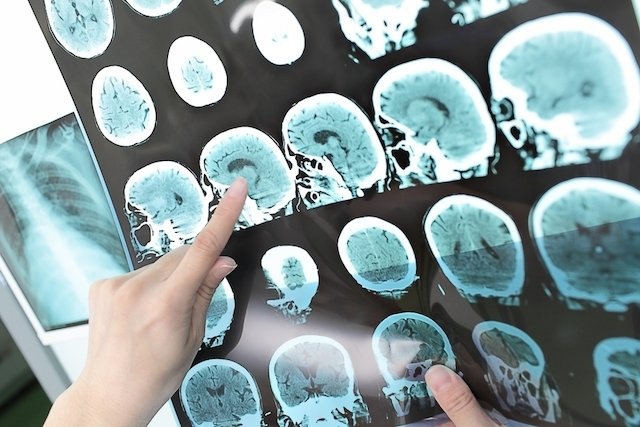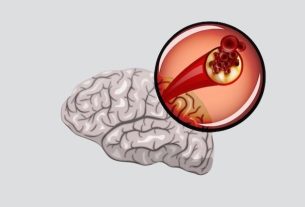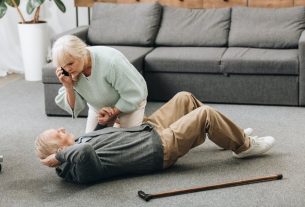A hemorrhagic stroke is when a cerebral vessel ruptures, causing bleeding at the site, which can cause symptoms such as intense headache, seizures, vomiting and loss of consciousness, and put the person’s life at risk.
Normally, hemorrhagic stroke occurs due to uncontrolled high blood pressure, but it can also be caused by the malformation of vessels in the brain, aneurysms and tumors, being more common in men over 55 years of age and smokers.
If a hemorrhagic stroke is suspected, it is recommended to seek an emergency room or call for medical help as soon as possible, because it is a serious condition that needs to be identified and treated quickly to avoid the development of sequelae.

Main symptoms
The main symptoms of hemorrhagic stroke are:
- Strong headache;
- Nausea;
- Vomiting;
- Difficulty speaking or swallowing;
- Mental confusion;
- Difficulty moving parts of the body, such as arms or legs;
- Lack of motor coordination;
- Double vision;
- Loss of consciousness;
- Loss of balance;
- Seizures.
If a hemorrhagic stroke is suspected, it is recommended to go to an emergency room for an evaluation or call for medical help, so that the diagnosis can be confirmed and appropriate treatment can be started as soon as possible. Find out how to start first aid in case of a stroke.
How to confirm the diagnosis
The diagnosis of a hemorrhagic stroke is normally made taking into account the symptoms presented and the results of tests such as computed tomography or magnetic resonance imaging, which allow visualization of the cerebral hemorrhage.
Possible causes
The most common causes of hemorrhagic stroke are:
- Untreated hypertension;
- Vessel malformations in the brain;
- Incorrect use of anticoagulant or antiplatelet medications;
- Use of illicit drugs, such as cocaine and amphetamine;
- Diseases that make blood clotting difficult, such as hemophilia;
- Vasculitis, which is the inflammation of vessels in the body;
- Aneurisma cerebral;
- Tumor cerebral.
Furthermore, hemorrhagic stroke is more common in men over 55 years of age, smokers, in cases of liver disease and excessive alcohol consumption, for example.
Differences between ischemic stroke and hemorrhagic stroke
Hemorrhagic stroke occurs when a vessel in the brain ruptures, causing a hematoma. Ischemic stroke is when blood circulation through a vessel in the brain is interrupted, by a clot, for example, impairing brain function. Learn about the main differences between the types of stroke.
How the treatment is carried out
Treatment of hemorrhagic stroke usually involves controlling blood pressure, bleeding and possible complications, such as seizures. Therefore, the use of medications such as antihypertensives, analgesics, sedatives and anticonvulsants may be indicated.
In more serious cases, especially when bleeding causes hydrocephalus or compression of parts of the brain, surgery may be necessary to prevent the person’s condition from worsening. Understand better how hemorrhagic stroke is treated.
Furthermore, rehabilitation with physiotherapy, speech therapy or occupational therapy, for example, may be indicated when the person is more stable, especially in the case of sequelae, being important to improve quality of life after a stroke.
Is there a cure for hemorrhagic stroke?
Hemorrhagic stroke can be cured in some cases, especially when it is identified and treated quickly. However, depending on the severity, the person may need to live with sequelae, even when rehabilitation is carried out properly.
Possible sequels
Hemorrhagic stroke can cause sequelae such as:
- Difficulty speaking or swallowing food;
- Loss of coordination of movements;
- Difficulty with reasoning and memory;
- Lack of balance;
- Decreased sensitivity in parts of the body;
- Difficulty moving parts of the body, such as arms and legs.
Furthermore, the risk of sequelae tends to be greater when hemorrhagic stroke takes time to be identified and treated appropriately.
How to prevent
Hemorrhagic stroke can be prevented through measures such as properly treating blood pressure, avoiding the consumption of alcohol, cigarettes or drugs and not using medications without medical advice, especially anticoagulants which, if taken incorrectly, can increase the risk of stroke.
Bibliography
- STATPEARLS. Intracerebral Hemorrhage. 2022. Available at: <https://www.ncbi.nlm.nih.gov/books/NBK553103/>. Accessed on 16 Dec 2022
- SCHRAG, Matthew; KIRSHNER, Howard. Management of Intracerebral Hemorrhage: JACC Focus Seminar. J Am Coll Cardiol. Vol.75, n.15. 1819-1831, 2020
- GROSS, Bradley A. et al. Cerebral Intraparenchymal Hemorrhage: A Review. JAMA. Vol.21, n.13. 1295-1303, 2019
- KALARIA, Raj N; ACKNOWLEDGMENT, Rufus; IHARA, Proverbs. Stroke injury, cognitive impairment and vascular dementia. Biochim Biophys Acta. Vol.1862, n.5. 915-925, 2016
- STATPEARLS. Hemorrhagic Stroke. 2022. Available at: <https://www.ncbi.nlm.nih.gov/books/NBK559173/>. Accessed on 16 Dec 2022
- OLIVEIRA, Roberto de Magalhães Carneiro et. al.. Stroke. Rev Bras Hipertens. Vol. 8. 3. ed; 2001
- AMERICAN STROKE ASSOCIATION. Hemorrhagic Stroke (Bleeds). Disponível em: <https://www.stroke.org/en/about-stroke/types-of-stroke/hemorrhagic-strokes-bleeds>. Acesso em 21 mai 2020
- PORTUGUESE CARDIOLOGY FOUNDATION. Stroke. 2014. Available at: <https://www.bombeiros.pt/wp-content/uploads/2014/10/acidentevascularcerebral1.pdf>. Accessed on February 17, 2020
- INEM. Medical emergencies. 2012. Available at: <https://www.inem.pt/wp-content/uploads/2017/06/Emerg%C3%AAncias-M%C3%A9dicas.pdf>. Accessed on February 17, 2020
- MINISTRY OF HEALTH. Manual of routines for stroke care. 2013. Available at: <http://bvsms.saude.gov.br/bvs/publicacoes/manual_rotinas_para_atencao_avc.pdf>. Accessed on February 17, 2020

Sign up for our newsletter and stay up to date with exclusive news
that can transform your routine!
Warning: Undefined array key "title" in /home/storelat/public_html/wp-content/plugins/link-whisper-premium/templates/frontend/related-posts.php on line 12
Warning: Undefined array key "title_tag" in /home/storelat/public_html/wp-content/plugins/link-whisper-premium/templates/frontend/related-posts.php on line 13



